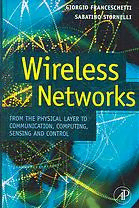Table Of ContentElsevierUS 0Prelims-P369426 15-3-2006 11:43a.m.
Wireless Networks
From the Physical Layer
to Communication, Computing,
Sensing, and Control
Edited by
Giorgio Franceschetti
Professor of Electromagnetic Theory,
University Fredrico II of Napoli, Italy
and
Sabatino Stornelli
CEO of Seicos and Selex-SeMa,
Finmeccanica Companies
AMSTERDAM•BOSTON•HEIDELBERG•LONDON
NEWYORK•OXFORD•PARIS•SANDIEGO
SANFRANCISCO•SINGAPORE•SYDNEY•TOKYO
AcademicPressisanimprintofElsevier
ElsevierUS 0Prelims-P369426 15-3-2006 11:43a.m.
AcademicPressisanimprintofElsevier
30CorporateDrive,Suite400,Burlington,MA01803,USA
525BStreet,Suite1900,SanDiego,California92101-4495,USA
84Theobald’sRoad,LondonWC1X8RR,UK
Thisbookisprintedonacid-freepaper.
Copyright©2006,ElsevierInc.Allrightsreserved.
Nopartofthispublicationmaybereproducedortransmittedinanyformorbyany
means,electronicormechanical,includingphotocopy,recording,oranyinformation
storageandretrievalsystem,withoutpermissioninwritingfromthepublisher.
PermissionsmaybesoughtdirectlyfromElsevier’sScience&TechnologyRights
DepartmentinOxford,UK:phone:(+44)1865843830,fax:(+44)1865853333,
E-mail:[email protected]
viatheElsevierhomepage(http://elsevier.com),byselecting“Support&Contact”
then“CopyrightandPermission”andthen“ObtainingPermissions.”
LibraryofCongressCataloging-in-PublicationData
Wirelessnetworks:fromthephysicallayertocommunication,computing,
sensing,andcontrol/editedbyGiorgioFranceschettiandSabatinoStornelli.
p. cm.
LecturespresentedinCapri,Italy,fallof2004.
Includesbibliographicalreferencesandindex.
ISBN-13:978-0-12-369426-3(pbk.:alk.paper)
ISBN-10:0-12-369426-4(pbk.:alk.paper)1.WirelessLANs—Congresses.
2.Personalcommunicationservicesystems—congresses.I.Franceschetti,
Giorgio.II.Stornelli,Sabatino.
TK5105.78.W5782006
004.6(cid:2)8—dc22
2005036150
BritishLibraryCataloguing-in-PublicationData
AcataloguerecordforthisbookisavailablefromtheBritishLibrary.
ISBN13:978-0-12-369426-3
ISBN10:0-12-369426-4
ForinformationonallAcademicPresspublications
visitourWebsiteatwww.books.elsevier.com
PrintedintheUnitedStatesofAmerica
06 07 08 09 10 9 8 7 6 5 4 3 2 1
Working together to grow
libraries in developing countries
www.elsevier.com | www.bookaid.org | www.sabre.org
ElsevierUS 0Prelims-P369426 15-3-2006 11:43a.m.
A cocktail of control, computing
Together with software and sensing,
Considered the latest boom,
Was tasted by a man in a room
While wireless nets he was using.
The man was sipping the beverage
By using the wisdom of his age.
He said that something was missing:
A book taking care of the fixing!
And this was well worth his wage!
– GF
This page intentionally left blank
ElsevierUS 0Prelims-P369426 15-3-2006 11:43a.m.
Contents
Foreword xv
Preface xvii
About the Authors xxiii
1
Wireless Networks and Their Context 1
1.1 Introduction 1
1.2 The Scenario 3
1.3 The Players 6
1.4 Concluding Remarks 11
2
The Wireless Communications Physical Layer 13
2.1 Historical Perspectives 13
2.2 Digital Communication Basics 14
2.2.1 Complex Baseband Representation
of Bandpass Signals 15
2.2.2 Digital Transmission 18
2.2.3 Performance Metrics for Digital
Communication 19
2.2.4 Some Limits on Performance of Digital
Communication Systems 22
2.2.5 Optimum Demodulation 24
2.2.6 Discussion 28
vii
ElsevierUS 0Prelims-P369426 15-3-2006 11:43a.m.
viii Contents
2.3 Orthogonal Modulations 29
2.3.1 Orthogonal Frequency Division Multiplexing 29
2.3.2 Orthogonal Code Division Multiplexing 32
2.3.3 Binary Stream Modulation 35
2.3.4 Orthogonal Modulations with Memory 37
2.4 Propagation in Wireless Channels 40
2.4.1 Free Space Propagation 41
2.4.2 Multipath Propagation 46
2.4.3 Gaussian Modeling of Multipath Channels 49
2.5 The Selectivity of Wireless Channels 51
2.5.1 Frequency Selectivity 52
2.5.2 Spatial Selectivity 57
2.5.3 Time Selectivity 63
2.5.4 Summary of Channel Characteristics 66
2.6 Physical Models of Wireless Systems 68
2.6.1 Time-Flat Frequency-Flat (TF/FF) Channels 70
2.6.2 Time-Varying Frequency-Flat
(TV/FF) Channels 72
2.6.3 Time-Flat Frequency-Varying
(TF/FV) Channels 73
2.6.4 Receiver-Space-Varying Frequency-Flat
(RSV/FF) Channel 73
2.6.5 Transmitter-Receiver Space-Varying
Frequency-Flat (TRSV/FF) Channel 74
2.6.6 Paradigms for Wireless Communication 75
2.7 Modern Wireless Communication 77
2.7.1 Capacity of the SISO Channel 79
2.7.2 Capacity of the SISO Varying Channel 82
ElsevierUS 0Prelims-P369426 15-3-2006 11:43a.m.
Contents ix
2.7.3 Capacity of the RSV/TF/FF Channel 83
2.7.4 MIMO Capacity 86
2.8 Conclusion 90
3
Handset Communication Antennas
Including Human Interactions 95
3.1 Introduction 95
3.1.1 Mobile Communication Systems 95
3.1.2 Antenna Designs for Handsets 98
3.1.3 Interaction with the Human 99
3.1.4 Objectives of this Chapter 100
3.2 Overview of Popular Handset Antennas 102
3.2.1 RF System Introduction 102
3.2.2 External Antennas 103
3.2.3 Internal Antennas 106
3.2.4 Non-Cellular Antennas 107
3.2.5 Key Electrical Parameters in
Handset Antenna Designs 109
3.3 Integration of Multiple Antennas 111
3.3.1 Dual-Band PIFA Design 112
3.3.2 PIFA and Whip Antenna Combination 113
3.3.3 PIFA and GPS IFA Combination 124
3.4 Human Interaction in Handset Antenna Design 134
3.4.1 Human Head Effect on Handset Antennas 135
3.4.2 SAR Consideration in Handset
Antenna Designs 139
3.4.3 SAR Reduction with a GPS IFA 144
ElsevierUS 0Prelims-P369426 15-3-2006 11:43a.m.
x Contents
3.5 Total Radiated Power (TRP) 146
3.5.1 Definition of TRP 147
3.5.2 PIFA Models in the 1900MHz Band 148
3.5.3 SAR and TRP 151
3.6 Conclusion 154
4
Wireless Channel Model 161
4.1 Introduction 161
4.1.1 The Deterministic Approach 162
4.1.2 The Stochastic Approach 164
4.2 The Deterministic Geometrical Model (DGM) 165
4.2.1 Input Data 166
4.2.2 Output Data 168
4.2.3 Rays Propagation, Reflection, and Diffraction 169
4.2.4 Results 172
4.3 The Stochastic Environment Model 172
4.3.1 The Large-Scatterers Model (SELM) 176
4.3.2 The Small-Scatterers Model (SESM) 177
4.3.3 Analytic Results 178
4.3.4 Validation 182
4.4 Conclusion 184
5
Ad Hoc Wireless Networks 187
5.1 Introduction and Definitions 187
5.1.1 Wireless Evolution 187
ElsevierUS 0Prelims-P369426 15-3-2006 11:43a.m.
Contents xi
5.1.2 Ad Hoc Network Characteristics 189
5.1.3 Wireless Network Taxonomy 191
5.2 Ad Hoc Network Applications 192
5.2.1 The Battlefield 193
5.2.2 Opportunistic Ad Hoc Networking in the
Urban Grid and on Campus 196
5.3 Design Challenges 198
5.3.1 Mobility and Scaling 199
5.3.2 Cross Layer Interaction 199
5.3.3 The Rest of this Chapter 200
5.4 Overview of Scalable Ad Hoc Routing Protocols 201
5.4.1 Routing in a Flat Network Address Structure 203
5.4.2 Hierarchical Routing Protocols 210
5.4.3 Geographic Position Information
Assisted Routing 218
5.5 The MINUTEMAN Project 224
5.6 Scalable Routing in MINUTEMAN 228
5.7 Backbone Node Deployment and Clustering 229
5.7.1 Random Competition-Based Clustering 230
5.7.2 Multihop Clustering 232
5.8 Scalable Routing: LANMAR 232
5.8.1 LANMAR in the MBN 232
5.8.2 Mobile IP Routing from the Internet 234
5.9 Simulation Experiments 234
5.9.1 Cluster Stability 235
5.9.2 Routing Algorithm Performance 236
ElsevierUS 0Prelims-P369426 15-3-2006 11:43a.m.
xii Contents
5.10 Related Work 237
5.11 Conclusion 238
6
Sensor Networks 243
6.1 Introduction 243
6.1.1 Motivation 243
6.1.2 Measured Data and Network Characteristics 244
6.1.3 Metrics 245
6.1.4 Related Work 246
6.1.5 Main Contributions and
Organization of the Chapter 248
6.2 Background 248
6.3 Problem Setting 250
6.3.1 Network Model 250
6.3.2 Signal Model 251
6.4 Data Gathering of Spatially
Correlated Random Processes 252
6.4.1 Lossless Data Gathering 252
6.4.2 Node Placement 266
6.4.3 Lossy Data Gathering 267
6.4.4 Remarks 272
6.5 Data Gathering of Spatio-Temporal Processes 273
6.5.1 Problem Setup 275
6.5.2 One-Dimensional Network 276
6.5.3 Two-Dimensional Model 282
6.5.4 Numerical Simulations 284
6.5.5 Remarks 285
6.6 Conclusion 286

